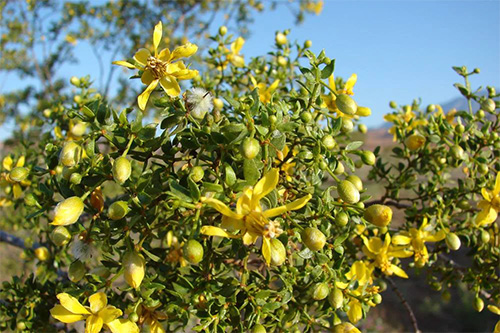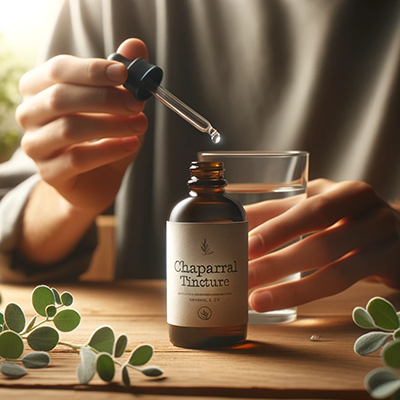The chaparral plant (Larrea divaricata) is a testament to nature’s resilience and adaptability. This plant is one of the best antibiotics. It is helpful against bacteria, viruses, and parasites internally and externally. It fights free radicals and chelates heavy metals.

Habitat and Distribution
The chaparral plant is primarily found in Mediterranean-type climates with typical dry summers and mild, wet winters. These regions include California, Oregon, parts of Chile, and Australia. The plant’s ability to adapt has allowed it to thrive on various soil types, ranging from sandy loam soils to rocky terrains, by using its extensive root system for anchorage.
The chaparral plant is a striking shrub that averages six to twelve feet (1.8 to 3.6 meters) in height. Its evergreen leaves are arranged in small clusters with needle-like formations, giving it its unique appearance.
The plant’s name, “greasewood,” comes from the oily substance found within its leaves, which creates a slightly greasy sensation when touched. This distinctive feature makes this plant stand out in any garden or landscape setting.
Ecological Role
The chaparral plant is an integral component of the intricate ecosystem in which it resides. As a primary producer, its contribution to sustaining life within this system cannot be overstated. It provides sustenance and shelter for various animals, including birds, insects, and small mammals that depend on it solely or partially for their survival needs, such as food sources or nesting materials.
Moreover, due to its dense growth pattern covering vast areas, many species find refuge from predators or harsh weather conditions underneath its canopy, making it indispensable in maintaining balance within nature’s delicate web of interdependence.
Fire Adaptation
The chaparral plant is an incredible example of how nature can adapt to survive even in the most challenging conditions. These ecosystems are prone to periodic fires, but rather than being defeated by them over time through evolutionary processes like serotiny, which allows seeds to germinate only after exposure to extreme heat from wildfires – ensuring their continued presence within these environments despite any potential setbacks caused by fire events. This adaptation has allowed this unique shrub’s existence and persistence throughout history to be a vital component of maintaining balance within its habitats.
The chaparral region is a biodiversity hotspot due to its unique combination of flora and fauna. Manzanita, ceanothus, and other drought-tolerant plants thrive alongside the chaparral, creating an intricate landscape. Endemic animals such as California gnatcatchers and island foxes call this ecosystem home. Protecting it from harmful influences like climate change or habitat destruction is essential for preserving these species’ existence.
Challenges and Conservation
The chaparral is a resilient ecosystem that thrives despite various environmental challenges. However, human activities such as urbanization, grazing, and agricultural expansion have significantly fragmented its habitats, putting many plant and animal species at risk. To preserve this unique biodiversity for future generations, we must prioritize conservation efforts to protect the chaparral from further harm caused by humans.
Chaparral Plant Health Benefits
- Parts used: Leaves
- Properties: Antibiotic, alternative, parasiticide
- What it affects: Stomach, intestines, and blood

The chaparral has been revered for centuries due to its supposed healing powers. While it’s important not to dismiss these claims outright, we must also acknowledge that scientific evidence may be lacking or inconclusive. However, the following are some of the many health benefits:
Antioxidant Capacity
Chaparral has long been recognized for its potential as an antioxidant due to the existence of compounds like nordihydroguaiaretic acid (NDGA). Antioxidants are essential in combating oxidative stress linked with various chronic conditions and aging processes. While laboratory studies have shown promising results regarding NDGA antioxidant effects, further research is needed before fully understanding how this translates into human health benefits.
Inflammation Reducing Effects
Chaparral has been used traditionally to treat inflammatory conditions such as arthritis and skin irritations. Some believe that its anti-inflammatory properties can alleviate joint pain while reducing redness on the surface of one’s skin. While animal studies have shown promise in this regard, further research is necessary to establish whether or not it’s safe and effective when applied by humans.
Boost Your Immune System
Chaparral has been used in folk medicine due to its purported ability to boost the immune system and protect against illnesses. The presence of flavonoids and other bioactive compounds may contribute to this effect. Still, clinical trials are needed before we can confirm these claims definitively. More research is necessary before fully understanding how chaparral works within our bodies.
Antimicrobial Effects
Certain cultures have long used chaparral as an antimicrobial agent for treating wounds and infections. Based on laboratory studies, plant extracts show promise against certain bacteria and fungi. However, natural remedies should not replace standard medical treatments for severe health issues or infectious diseases.
Detox Support
Some proponents of chaparral have linked it with detoxification, believing it can aid the body through its impact on liver function. This belief is based on the idea that bioactive compounds in this plant may support liver health and enhance natural bodily mechanisms for eliminating toxins from our system. However, comprehensive human studies are needed before we can confirm whether or not chaparral use as a supplement for detoxification is safe and effective.
Chaparral Side Effects
While the potential health benefits of chaparral are enticing, caution is necessary. The plant contains compounds that may be toxic when consumed in large quantities leading to liver damage and other adverse effects. Regulatory authorities have issued warnings about high doses of supplements containing this herb due to its risks for users.
Chaparral may have adverse effects on certain medications or pre-existing health conditions. Pregnant and breastfeeding individuals and those with liver or kidney disorders should refrain from consuming chaparral due to potential risks. Chaparral is a popular natural remedy, but its side effects should not be ignored.
Liver Toxicity
There have been reports of acute hepatitis and liver failure linked with the intake of products containing chaparrals extracts or derivatives. This is because it has potent compounds that, when consumed excessively over an extended period, could severely damage your liver’s functioning abilities – something you cannot afford, given how critical detoxification processes are within our bodies! Therefore, anyone considering using any substance known for causing such adverse effects should proceed cautiously while keeping all potential risks in mind.
Gastrointestinal Disorders
Chaparral has been known to cause gastrointestinal problems such as nausea, vomiting, and diarrhea. This is due to the plant’s bioactive compounds interacting with our bodies. Those with sensitive stomachs or pre-existing GI conditions should exercise caution when considering chaparral for medicinal purposes.
Photosensitivity
Chaparral products have been associated with an increased risk of photosensitivity in some users. This condition can manifest as rashes, redness, or heightened susceptibility to sunburns when exposed for prolonged periods under direct sunlight. To avoid any adverse effects while using chaparral externally on your skin, you must take precautions against excessive sun exposure.
Allergies

Some individuals may experience adverse reactions due to allergies. These can manifest as skin rashes, hives, or respiratory issues such as difficulty breathing. If you notice these symptoms after taking chaparral, discontinue use immediately and seek medical attention promptly.
Medication Interactions
Chaparral can potentially interact with certain medications that are metabolized by the liver. If taken together, this interaction could affect how well these drugs work or lead to adverse reactions. It is essential for individuals taking any herbal supplements or remedies like chaparral to inform their healthcare providers about this use so they may avoid potential drug interactions and ensure the safe usage of all medicines being consumed simultaneously.
Pregnancy and Breastfeeding
Chaparral has not been proven safe for use during pregnancy or breastfeeding. Therefore, avoiding using any products containing this herb is advisable if you are currently expecting a child or nursing one already. The potential risks of consuming chaparral could harm both the mother and baby, discouraging its usage in these circumstances.
The safety concerns surrounding chaparral have prompted certain health authorities to take regulatory actions to safeguard public well-being. Some regions have restricted the use of products containing this plant. In contrast, others have issued warnings regarding its potential adverse effects. It’s crucial for individuals considering using or consuming chaparral to be mindful of these regulations and factor them into their decision-making process accordingly.
NOTE: Chaparral is very bitter and is usually mixed with other herbs or taken in tincture form. Pau d’ arco (Tabebuia heptaphylla), also called lapacho or taheebo, has similar antibiotic and anti-cancer properties but is less harsh than chaparral.
Preparation and Dosage
- Infusion: Steep for 5 to 15 minutes, and take 6 ounces thrice daily.
- Tincture: Take 10 to 20 drops three times daily.
- Powder: Take 2 to 10 #0 capsules (10 to 60 grains) thrice daily.
Health Disclaimer: The information on this website is for educational uses only and is not a substitute for professional medical advice. Always consult an authorized healthcare provider for any health concerns before using any herbal or natural remedy. We do not establish, treat, cure, or prevent any disease. Reliance on any material from this website is solely at your own risk. We are not responsible for any adverse effects resulting from the use of information or products mentioned on this website.
REFERENCES
- Vance Ferrell Harold M. Cherne, M.D. The Natural Remedies Encyclopedia [Book]. – Altamont, TN: Harvestime Books, 2010. – Vol. Seventh Edition: 7: pp. 151.
- About Herbs: Chaparral: https://www.mskcc.org/cancer-care/integrative-medicine/herbs/chaparral
